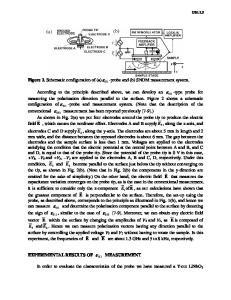Measurement of Electrical Charge During Nanoindentation of Ferroelectric Thin Films
- PDF / 57,502 Bytes
- 6 Pages / 612 x 792 pts (letter) Page_size
- 11 Downloads / 369 Views
Measurement of Electrical Charge during Nanoindentation of Ferroelectric Thin Films
M. Algueró, A.J. Bushby and M.J. Reece Department of Materials. Queen Mary, University of London. Mile End Road, London E1 4NS, United Kingdom Electrical charge transients have been measured during the nanoindentation of lanthanum modified lead titanate ferroelectric thin films. Using the spherical indenter as the top electrode, the films were locally poled. The films were then reindented at the exact same positions. The origin of the charge released is discussed in terms of piezoelectricity and depolarisation. The depolarisation must have been produced by a stress induced ferroelastic domain reorientation. Current intensity transients recorded during indentation showed a distinct maximum. This maximum corresponded to a force at which the depolarisation rate was a maximum. This provides the basis to define a coercive indentation force, and then a coercive indentation stress. INTRODUCTION Ferroelectric thin films are being integrated into Microelectromechanical Systems (MEMS) as piezoelectric sensors and actuators [1]. An example is the force sensor for atomic force microscopy [2]. In this microdevice, the ferroelectric film is integrated into a Si micromachined cantilever. Another example is the ultrasonic micromotor [3]. In this case, the ferroelectric film is integrated with a Si3N4 membrane micromachined from a Si wafer. Ferroelectric compositions that are under consideration for MEMS applications are mainly lead zirconate titanate (PZT) [4]. An alternative material that has also attracted attention is lanthanum modified lead titanate (PTL) [5]. Films prepared on Si-based substrates are polycrystalline. Although a preferred mixed [001]/[100] or [111] orientation can be induced [6], the 180o domains are not always preferentially aligned and the as deposited films do not show significant electrical polarisation. In order to achieve useable piezoelectric coefficients, a poling treatment is necessary [7]. The electrical polarisation induced by poling for ferroelectric ceramics is not stable under a compressive stress along the poling direction [8]. Stress induced depolarisation occurs by the movement of the ferroelastic, non-180o, domain walls. The threshold stress for depolarisation of a piezoelectric ceramic actuator is an important design parameter. The corresponding threshold stresses for depolarisation in ferroelectric films are also required for MEMS design. However, no such data currently exists as far as we know. We present here results of the charge transients produced by the nanoindentation of poled PTL films. The origin of the charge is discussed in terms of piezoelectricity and depolarisation. The possibility of defining a stress threshold for depolarisation is discussed. EXPERIMENTAL The experiments were carried out with a UMIS 2000 nanoindentation systema. A WC-Co cermet spherical indenter with a nominal radius of 100 µm was used. The system allows the application of forces up to 500 mN with a sensitivity of 10 µN. The
Data Loading...










